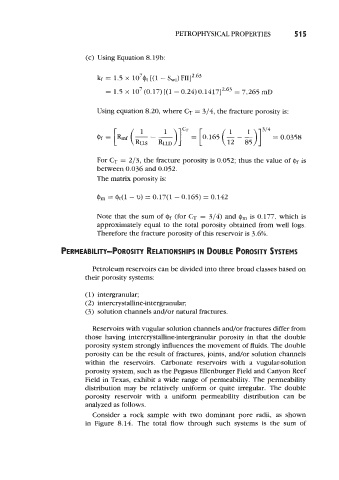Page 548 - Petrophysics
P. 548
PETROPHYSICAL PROPERTIES 515
(c) Using Equation 8.19b:
kf = 1.5 x 107@t [(l - Swi)FII]2.63
= 1.5 x lo7 (0.17) [(l - 0.24)0.1417]2.63 = 7,265 mD
Using equation 8.20, where CT = 3/4, the fracture porosity is:
Qf = [Rd (& - &)IcT = b.165 (A - -$)I 314 = 0.0358
For CT = 2/3, the fracture porosity is 0.052; thus the value of @f is
between 0.036 and 0.052.
The matrix porosity is:
Qm = @t(l - U) = 0.17(1 - 0.165) 0.142
Note that the sum of Qf (for CT = 3/4) and @m is 0.177, which is
approximately equal to the total porosity obtained from well logs.
Therefore the fracture porosity of this reservoir is 3.6%.
PERMEABILITY-POROSITY RELATIONSHIPS IN DOUBLE POROSITY SYSTEMS
Petroleum reservoirs can be divided into three broad classes based on
their porosity systems:
(1) intergranular;
(2) intercrystalline-intergranular;
(3) solution channels and/or natural fractures.
Reservoirs with vugular solution channels and/or fractures differ from
those having intercrystalline-intergranular porosity in that the double
porosity system strongly influences the movement of fluids. The double
porosity can be the result of fractures, joints, and/or solution channels
within the reservoirs. Carbonate reservoirs with a vugular-solution
porosity system, such as the Pegasus Ellenburger Field and Canyon Reef
Field in Texas, exhibit a wide range of permeability. The permeability
distribution may be relatively uniform or quite irregular. The double
porosity reservoir with a uniform permeability distribution can be
analyzed as follows.
Consider a rock sample with two dominant pore radii, as shown
in Figure 8.14. The total flow through such systems is the sum of

